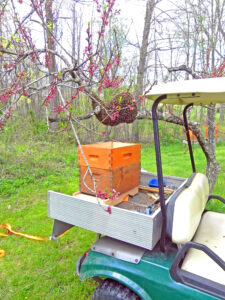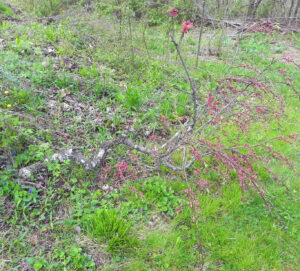Swarm Season is Upon Us
“Anyone who thinks they’re too small to make a difference, has never met the honey bee.” Unknown
It seems the bees swarm earlier every year. Two weeks ago, which would have been early April, a friend called and said her bees had swarmed. Oh boy. It was time to get the bait hives out and the swarm boxes ready to go. It was a good thing we did just that because we would soon need them. We would not have worried about swarms until late April or early May a few years back. No more.
A few days ago, I was stretched out in my recliner, just getting settled in for a little siesta, when Ellis blew through the front door and announced, “We have a swarm!” What a way to ruin a much-needed nap! The thing with swarms is that they may hang there for a day or two, or they could be there one minute and gone the next. You just don’t know. Our rule of thumb is to assume they will not be there for long. If you dawdle around, you might just be standing there watching the grand spectacle as they take flight and disappear, never to be seen again. It is a grand spectacle, too, especially if you witness them pouring from the hive and the air becomes filled with bees. It is an amazing phenomenon that is hard to fathom: how they know when to leave, where they are going, and how to get there. When do they know it is time for the swarm to depart? Who gives the signal when it is time? How do they know who to follow and where they are going? Once they go to the temporary stopping place, who gives the signal to go again to their final destination? After almost two decades of keeping bees, many unsolved mysteries and questions remain. They are a super complex society that always keeps us guessing.
 Back to swarm catching. Luckily, the swarm was very accommodating and clustered on an old peach tree not far from the hive they had just left. Swarming is something dedicated, hardcore beekeepers try to prevent. Over the years, we have found that once the bees get it in their tiny little bee brains to swarm, there isn’t much you can do to change their minds. We just let them do what they naturally want to do because we are not desperate to harvest honey; we mostly just like them for the additional pollination they provide. While we are beekeepers, we are also native bee enthusiasts and try to encourage and provide habitat for the many important and beneficial native bees and other pollinators in our area.
Back to swarm catching. Luckily, the swarm was very accommodating and clustered on an old peach tree not far from the hive they had just left. Swarming is something dedicated, hardcore beekeepers try to prevent. Over the years, we have found that once the bees get it in their tiny little bee brains to swarm, there isn’t much you can do to change their minds. We just let them do what they naturally want to do because we are not desperate to harvest honey; we mostly just like them for the additional pollination they provide. While we are beekeepers, we are also native bee enthusiasts and try to encourage and provide habitat for the many important and beneficial native bees and other pollinators in our area.
We hustled around and gathered our bee equipment and a hive body to put the swarm in. Catching swarms and beekeeping, in general, are good tests of how strong your marriage is. During almost fifty years of marriage, some of our most heated discussions have arisen during beekeeping chores and catching swarms. We often have very different thoughts on how we should proceed. We always work it out (yes, dear, whatever you think!)

Luckily, the swarm was just a few feet off the ground, so we backed the golf cart bed with the hive body directly under it. “This should be a piece of cake,” we said. We were quite full of ourselves at how easy this capture would be. No climbing ladders carrying a saw and a heavy hive body. No cutting off branches way above your head. No shimmying up trees or dangling from limbs like a monkey.
Have you ever watched one of those daytime TV shows where they show a video of someone doing something stupid and then ask the audience how they think it will turn out? Ellis was holding the end of the limb to keep it steady. Just as I was about to begin sweeping bees off the limb into the box, Ellis, trying to make my job easier, pulled down on the limb to bring the swarm closer to the box. Crack!! The entire limb broke off the peach tree!

What did I say? Well, I was a sailor, you know, so it wasn’t “oh fudge”! The limb fell onto the hive body, and bees went everywhere. Part of the swarm had plopped into the box, and the other several thousand were very unhappily engulfing us. We only hoped the queen was in the cluster that had plopped into the box. The bed of the golf cart was crawling with confused bees scrambling to orient themselves and find their queen.
 Ellis held the decayed limb up while I tried to sweep any remaining bees into the box. We slapped the inner cover on and waited to see if the outside bees headed for the inside of the box, indicating the queen was indeed inside. And they did. After a few minutes, the air was no longer filled with bees as they marched into the box just as they were supposed to.
Ellis held the decayed limb up while I tried to sweep any remaining bees into the box. We slapped the inner cover on and waited to see if the outside bees headed for the inside of the box, indicating the queen was indeed inside. And they did. After a few minutes, the air was no longer filled with bees as they marched into the box just as they were supposed to.
 We left the box to sit there for the afternoon, waiting until almost dark to close the entrance and move the hive. A minor complication popped up as we were in a severe storm warning by early evening. We decided we better get them moved even though a few bees might be left behind, and we were glad we did. Soon after getting them onto the bee stand and retreating to the house, the sky opened up: black clouds rolled in, lightning lit up the sky all around us, and thunder boomed. But, our new bee colony was snug in its new box and ready to begin work the next day. Another successful swarm capture. No need for marriage counseling!
We left the box to sit there for the afternoon, waiting until almost dark to close the entrance and move the hive. A minor complication popped up as we were in a severe storm warning by early evening. We decided we better get them moved even though a few bees might be left behind, and we were glad we did. Soon after getting them onto the bee stand and retreating to the house, the sky opened up: black clouds rolled in, lightning lit up the sky all around us, and thunder boomed. But, our new bee colony was snug in its new box and ready to begin work the next day. Another successful swarm capture. No need for marriage counseling!

This made me think of a book I read, “The Music of Bees” by Eileen Garvin. I loved the photos!! Ren